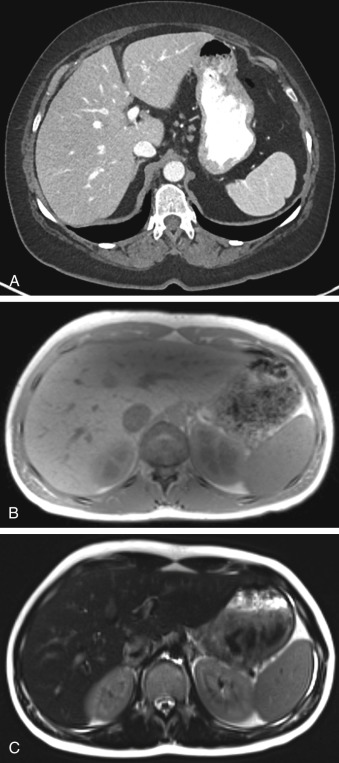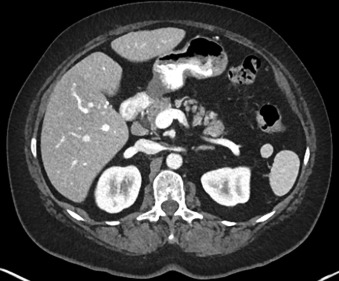Physical Address
304 North Cardinal St.
Dorchester Center, MA 02124
The normal spleen has homogeneous soft tissue attenuation on unenhanced CT, usually 5 to 10 HU less than liver, and appears slightly hypointense on T1-weighted images and hyperintense on T2-weighted images relative to liver ( Figure 29-1 ). It is typically less than 13 cm in craniocaudal dimension and has an average volume of ≈225 ml in adults. Splenic clefts are commonly seen, which are smooth curvilinear infoldings of the splenic surface without surrounding fluid ( Figure 29-1, A ).

During the arterial phase of enhancement (≈20 to 35 seconds after intravenous [IV] contrast administration), the spleen typically appears to have alternating bands of low and high CT attenuation or T1-weighted MRI signal intensity known as the arciform enhancement pattern ( Figure 29-2, A ). Variation from this pattern suggests presence of diffuse splenic disease. During the venous phase of enhancement (≈50 to 75 seconds after IV contrast administration), contrast material equilibrates in the spleen such that homogeneous intense enhancement is observed ( Figure 29-2, B ).

The spleen is composed of white pulp and red pulp, which are indistinguishable on CT or MR images. The white pulp is comprised of lymphatic tissue, whereas the red pulp is composed of venous sinuses and cellular splenic cords.
An accessory spleen (also known as a splenule) is a discrete focus of normal splenic tissue that is separate from the spleen, usually 1 to 2 cm in size, and may be single or multiple. CT attenuation and MRI signal intensity properties of an accessory spleen are identical to those of the normal spleen ( Figure 29-3 ). This is encountered in ≈10% to 30% of patients, usually within the splenic hilum or near/within the pancreatic tail, and is important to recognize prior to planned splenectomy for treatment of patients with hematologic or autoimmune disorders.

This is a normal variant due to abnormal splenic rotation, where the hilum is superiorly located and the convex border is medial and adjacent to the left kidney.
Splenosis is the spread of splenic tissue anywhere within the torso, most commonly in the peritoneal cavity, due to prior trauma or splenectomy. This is a potential mimic of peritoneal spread of tumor, although the attenuation, signal intensity, and enhancement properties are similar to those of normal splenic tissue. Uptake of 99m Tc sulfur colloid or 99m Tc heat damaged red blood cells on scintigraphy is diagnostic.
Become a Clinical Tree membership for Full access and enjoy Unlimited articles
If you are a member. Log in here